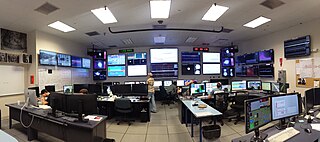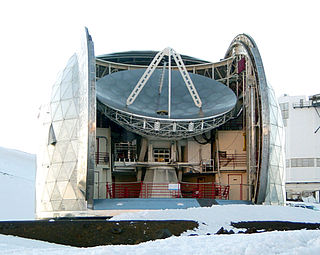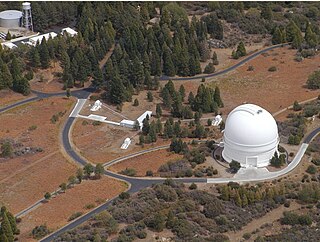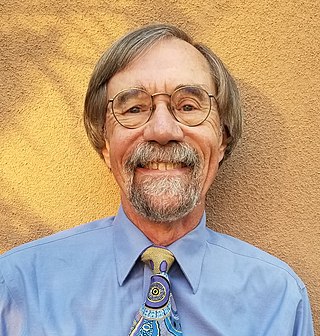Related Research Articles

The Laser Interferometer Gravitational-Wave Observatory (LIGO) is a large-scale physics experiment and observatory designed to detect cosmic gravitational waves and to develop gravitational-wave observations as an astronomical tool. Two large observatories were built in the United States with the aim of detecting gravitational waves by laser interferometry. These observatories use mirrors spaced four kilometers apart which are capable of detecting a change of less than one ten-thousandth the charge diameter of a proton.
In physics, coherence expresses the potential for two waves to interfere. Two monochromatic beams from a single source always interfere. Physical sources are not strictly monochromatic: they may be partly coherent. Beams from different sources are mutually incoherent.

The Laser Interferometer Space Antenna (LISA) is a planned space probe to detect and accurately measure gravitational waves—tiny ripples in the fabric of spacetime—from astronomical sources. LISA will be the first dedicated space-based gravitational-wave observatory. It aims to measure gravitational waves directly by using laser interferometry. The LISA concept has a constellation of three spacecraft arranged in an equilateral triangle with sides 2.5 million kilometres long, flying along an Earth-like heliocentric orbit. The distance between the satellites is precisely monitored to detect a passing gravitational wave.

In physics, a squeezed coherent state is a quantum state that is usually described by two non-commuting observables having continuous spectra of eigenvalues. Examples are position and momentum of a particle, and the (dimension-less) electric field in the amplitude and in the mode of a light wave. The product of the standard deviations of two such operators obeys the uncertainty principle:
In theoretical physics, Euclidean quantum gravity is a version of quantum gravity. It seeks to use the Wick rotation to describe the force of gravity according to the principles of quantum mechanics.
In physics, the Hanbury Brown and Twiss (HBT) effect is any of a variety of correlation and anti-correlation effects in the intensities received by two detectors from a beam of particles. HBT effects can generally be attributed to the wave–particle duality of the beam, and the results of a given experiment depend on whether the beam is composed of fermions or bosons. Devices which use the effect are commonly called intensity interferometers and were originally used in astronomy, although they are also heavily used in the field of quantum optics.

The Caltech Submillimeter Observatory (CSO) was a 10.4-meter (34 ft) diameter submillimeter wavelength telescope situated alongside the 15-meter (49 ft) James Clerk Maxwell Telescope (JCMT) at Mauna Kea Observatories. It was engaged in submillimeter astronomy, of the terahertz radiation band. The telescope closed on September 18, 2015.

The Palomar Testbed Interferometer (PTI) was a near infrared, long-baseline stellar interferometer located at Palomar Observatory in north San Diego County, California, United States. It was built by Caltech and the Jet Propulsion Laboratory and was intended to serve as a testbed for developing interferometric techniques to be used at the Keck Interferometer. It began operations in 1995 and achieved routine operations in 1998, producing more than 50 refereed papers in a variety of scientific journals covering topics from high precision astrometry to stellar masses, stellar diameters and shapes. PTI concluded operations in 2008 and has since been dismantled.
An atom interferometer is an interferometer which uses the wave character of atoms. Similar to optical interferometers, atom interferometers measure the difference in phase between atomic matter waves along different paths. Today, atomic interference is typically controlled with laser beams. Atom interferometers have many uses in fundamental physics including measurements of the gravitational constant, the fine-structure constant, the universality of free fall, and have been proposed as a method to detect gravitational waves. They also have applied uses as accelerometers, rotation sensors, and gravity gradiometers.

GEO600 is a gravitational wave detector located near Sarstedt, a town 20 km to the south of Hanover, Germany. It is designed and operated by scientists from the Max Planck Institute for Gravitational Physics, Max Planck Institute of Quantum Optics and the Leibniz Universität Hannover, along with University of Glasgow, University of Birmingham and Cardiff University in the United Kingdom, and is funded by the Max Planck Society and the Science and Technology Facilities Council (STFC). GEO600 is capable of detecting gravitational waves in the frequency range 50 Hz to 1.5 kHz, and is part of a worldwide network of gravitational wave detectors. This instrument, and its sister interferometric detectors, when operational, are some of the most sensitive gravitational wave detectors ever designed. They are designed to detect relative changes in distance of the order of 10−21, about the size of a single atom compared to the distance from the Sun to the Earth. Construction on the project began in 1995.
Quantum metrology is the study of making high-resolution and highly sensitive measurements of physical parameters using quantum theory to describe the physical systems, particularly exploiting quantum entanglement and quantum squeezing. This field promises to develop measurement techniques that give better precision than the same measurement performed in a classical framework. Together with quantum hypothesis testing, it represents an important theoretical model at the basis of quantum sensing.

An astronomical interferometer or telescope array is a set of separate telescopes, mirror segments, or radio telescope antennas that work together as a single telescope to provide higher resolution images of astronomical objects such as stars, nebulas and galaxies by means of interferometry. The advantage of this technique is that it can theoretically produce images with the angular resolution of a huge telescope with an aperture equal to the separation, called baseline, between the component telescopes. The main drawback is that it does not collect as much light as the complete instrument's mirror. Thus it is mainly useful for fine resolution of more luminous astronomical objects, such as close binary stars. Another drawback is that the maximum angular size of a detectable emission source is limited by the minimum gap between detectors in the collector array.

The Virgo interferometer is a large Michelson interferometer designed to detect the gravitational waves predicted by general relativity. It is located in Santo Stefano a Macerata, near the city of Pisa, Italy. The instrument's two arms are three kilometres long, housing its mirrors and instrumentation inside an ultra-high vacuum.

Carlton Morris Caves is an American theoretical physicist. He is currently professor emeritus and research professor of physics and astronomy at the University of New Mexico. Caves works in the areas of physics of information; information, entropy, and complexity; quantum information theory; quantum chaos, quantum optics; the theory of non-classical light; the theory of quantum noise; and the quantum theory of measurement. He is a Fellow of the American Physical Society and of the American Association for the Advancement of Science and is a member of the US National Academy of Sciences.

Francisco Javier "Frank" Duarte is a laser physicist and author/editor of several books on tunable lasers.
The N-slit interferometer is an extension of the double-slit interferometer also known as Young's double-slit interferometer. One of the first known uses of N-slit arrays in optics was illustrated by Newton. In the first part of the twentieth century, Michelson described various cases of N-slit diffraction.
A common-path interferometer is a class of interferometers in which the reference beam and sample beams travel along the same path. Examples include the Sagnac interferometer, Zernike phase-contrast interferometer, and the point diffraction interferometer. A common-path interferometer is generally more robust to environmental vibrations than a "double-path interferometer" such as the Michelson interferometer or the Mach–Zehnder interferometer. Although travelling along the same path, the reference and sample beams may travel along opposite directions, or they may travel along the same direction but with the same or different polarization.
Continuous-variable (CV) quantum information is the area of quantum information science that makes use of physical observables, like the strength of an electromagnetic field, whose numerical values belong to continuous intervals. One primary application is quantum computing. In a sense, continuous-variable quantum computation is "analog", while quantum computation using qubits is "digital." In more technical terms, the former makes use of Hilbert spaces that are infinite-dimensional, while the Hilbert spaces for systems comprising collections of qubits are finite-dimensional. One motivation for studying continuous-variable quantum computation is to understand what resources are necessary to make quantum computers more powerful than classical ones.
Alan David White was an American physicist, known primarily as one of the inventors of the visible helium-neon laser.

Rana X. Adhikari is an American experimental physicist. He is a professor of physics at the California Institute of Technology (Caltech) and an associate faculty member of the International Centre for Theoretical Sciences of Tata Institute of Fundamental Research (ICTS-TIFR).
References
- ↑ On Wings of Care Archived 2019-01-01 at the Wayback Machine , accessed 4 Jan 2019
- 1 2 3 4 "Bonny Schumaker: one woman's journey from rocket scientist to cat pilot". AL.com. 2012-03-13. Retrieved 2018-12-31.
- 1 2 Bonny L. Schumaker at the Mathematics Genealogy Project.
- 1 2 Schumaker, Bonny Laura (1985). Theoretical Investigations in Nonlinear Quantum Optics, Theory of Measurement, and Pulsations of General Relativistic Models of Neutron Stars (phd thesis). California Institute of Technology.
- ↑ Schumaker, Bonny L. (1984-05-01). "Noise in homodyne detection" (PDF). Optics Letters. 9 (5): 189–191. Bibcode:1984OptL....9..189S. doi:10.1364/OL.9.000189. ISSN 1539-4794. PMID 19721539.
- ↑ Caves, Carlton M.; Schumaker, Bonny L. (1985). "New formalism for two-photon quantum optics. I. Quadrature phases and squeezed states". Physical Review A . 31 (5): 3068–3092. Bibcode:1985PhRvA..31.3068C. doi:10.1103/PhysRevA.31.3068. PMID 9895862.
Caves, Carlton M.; Schumaker, Bonny L. (1985). "New formalism for two-photon quantum optics. II. Mathematical foundation and compact notation". Physical Review A . 31 (5): 3093–3111. Bibcode:1985PhRvA..31.3093S. doi:10.1103/PhysRevA.31.3093. PMID 9895863. - ↑ Caves, Carlton M. (1988-02-26). "Final Report for Caltech (California Institute of Technology) Contract No. N00014-85-K-0005" (PDF). Defense Technical Information Center . Archived (PDF) from the original on June 1, 2022. Retrieved 2018-12-31.
- ↑ Danilishen, Stefan L.; Khalili, Farid Ya. (2012). "Quantum Measurement Theory in Gravitational-Wave Detectors". Living Reviews in Relativity . 15 (1): 5. arXiv: 1203.1706 . Bibcode:2012LRR....15....5D. doi:10.12942/lrr-2012-5. PMC 5256003 . PMID 28179836.
- ↑ "Caltech Astronomy Graduate Alumni". lco.global. Retrieved 2018-12-31.
- ↑ "Maria Goeppert Mayer Award". www.aps.org. Retrieved 2018-12-31.
- ↑ "FermiNews - October 20, 2000". www.fnal.gov. Retrieved 2018-12-31.
- ↑ "American Physical Society Honors Seven Physicists at April Meeting". Physics Today . 49 (9): 123–126. 1988. Bibcode:1988PhT....41i.123.. doi:10.1063/1.2811572.
- 1 2 "Altadena's Bonnie Schumaker takes to the sky for animals". altadenablog. Retrieved 2018-12-31.
- ↑ Reasenberg, Robert D.; Babcock, Robert W.; Murison, Marc A.; Noecker, Martin C.; Phillips, James D.; Schumaker, Bonny L.; Ulvestad, James S. (1994-06-01). Breckinridge, James B. (ed.). "POINTS: an astrometric spacecraft with multifarious applications". Amplitude and Intensity Spatial Interferometry II. 2200: 2–17. Bibcode:1994SPIE.2200....2R. doi:10.1117/12.177228. S2CID 128813273.
- ↑ B., Schumaker. Spacecraft and Mission Design for the Precision Optical INTerferometer in Space (POINTS). OCLC 703661163.
- ↑ Schumaker, Bonny L. (2003). "Disturbance reduction requirements for LISA". Classical and Quantum Gravity. 20 (10): S239–S253. Bibcode:2003CQGra..20S.239S. doi:10.1088/0264-9381/20/10/327. ISSN 0264-9381. S2CID 250822225.
- ↑ "HEAD - Newsletter No. 90, Nov 2007". cxc.harvard.edu. Retrieved 2018-12-31.
- ↑ "FireSat - Global Fire Monitoring Centre" (PDF). gfmc.online. Retrieved 2018-12-31.
- ↑ Astro-GR, LISA's Disturbance Reduction System (2/2) by Bonny Schumaker - GW Course: astro-gr.org , retrieved 2018-12-31
- ↑ Astro-GR, LISA's Disturbance Reduction System (1/2) by Bonny Schumaker - GW Course: astro-gr.org , retrieved 2018-12-31
- ↑ "Participants - Cosmos". www.cosmos.esa.int. Retrieved 2018-12-31.
- ↑ "Milestones for LISA AMIGOS* Development" (PDF). labcit.ligo.caltech.edu. Retrieved 2018-12-31.
- ↑ "HEAD - Newsletter No. 92, May 2008". head.aas.org. Retrieved 2018-12-31.
- ↑ Irion, Robert (2002-08-16). "Gravitational Wave Hunters Take Aim at the Sky". Science. 297 (5584): 1113–1115. doi:10.1126/science.297.5584.1113. ISSN 1095-9203. PMID 12183608. S2CID 206577351.
- ↑ "PNNL: Keeping Carbon in Check". www.pnnl.gov. Retrieved 2018-12-31.
- ↑ Brown, David J.; Hunt, E. Raymond; Izaurralde, R. César; Paustian, Keith H.; Rice, Charles W.; Schumaker, Bonny L.; West, Tristram O. (2010). "Soil Organic Carbon Change Monitored Over Large Areas". Eos, Transactions American Geophysical Union. 91 (47): 441–442. Bibcode:2010EOSTr..91..441B. doi:10.1029/2010EO470001. ISSN 2324-9250.
- ↑ https://www.2343ec78a04c6ea9d80806345d31fd78-gdprlock/pg/SeaShepherdUK/about (2010-10-19). "Sea Shepherd's Operation Gulf Rescue Continues Six Months After Spil". Sea Shepherd UK. Retrieved 2018-12-31.
{{cite web}}: CS1 maint: numeric names: authors list (link) - 1 2 "Bonny Schumaker, Author at LA Progressive". LA Progressive. 10 July 2013. Retrieved 2018-12-31.
- ↑ Nienaber, Georgianne (2011-09-09). "Gulf Research Pilot Troubled by Oil Sighting in Macondo Prospect". Huffington Post. Retrieved 2018-12-31.
- ↑ Nienaber, Georgianne (2010-07-28). "Flyover at the Macondo Wellhead: Damage Control at "The Source"". Huffington Post. Retrieved 2018-12-31.
- ↑ L., Schumaker, Bonny (2012-04-15). The Story of Pellie Lou : a Pelican who survived the Gulf of Mexico oil spill (First printing ed.). New Orleans, LA. ISBN 9780985501105. OCLC 954587484.
{{cite book}}: CS1 maint: location missing publisher (link) CS1 maint: multiple names: authors list (link) - ↑ Reveal (2017-11-09), Since the Spill , retrieved 2018-12-31
- ↑ "The Aftermath". Reveal. 2017-11-13. Retrieved 2018-12-31.
- ↑ Castellana, Deb (2010-08-02). "Bonny Schumaker ~ An angel flying 'On Wings of Care'". Planet Ocean News. Archived from the original on 2019-01-01. Retrieved 2018-12-31.
- ↑ Smith, Stuart H. (2015-01-13). Crude Justice: How I Fought Big Oil and Won, and What You Should Know About the New Environmental Attack on America. BenBella Books, Inc. ISBN 9781940363448.
- ↑ AWE NEWS, Dr. Bonny Schumaker of "On Wings of Care" over Louisiana Coastal Waters , retrieved 2018-12-31
- ↑ Garcia-Pineda, Oscar; MacDonald, Ian; Silva, Mauricio; Shedd, William; Daneshgar Asl, Samira; Schumaker, Bonny (2016-07-01). "Transience and persistence of natural hydrocarbon seepage in Mississippi Canyon, Gulf of Mexico". Deep Sea Research Part II: Topical Studies in Oceanography. 129: 119–129. Bibcode:2016DSRII.129..119G. doi: 10.1016/j.dsr2.2015.05.011 . ISSN 0967-0645.